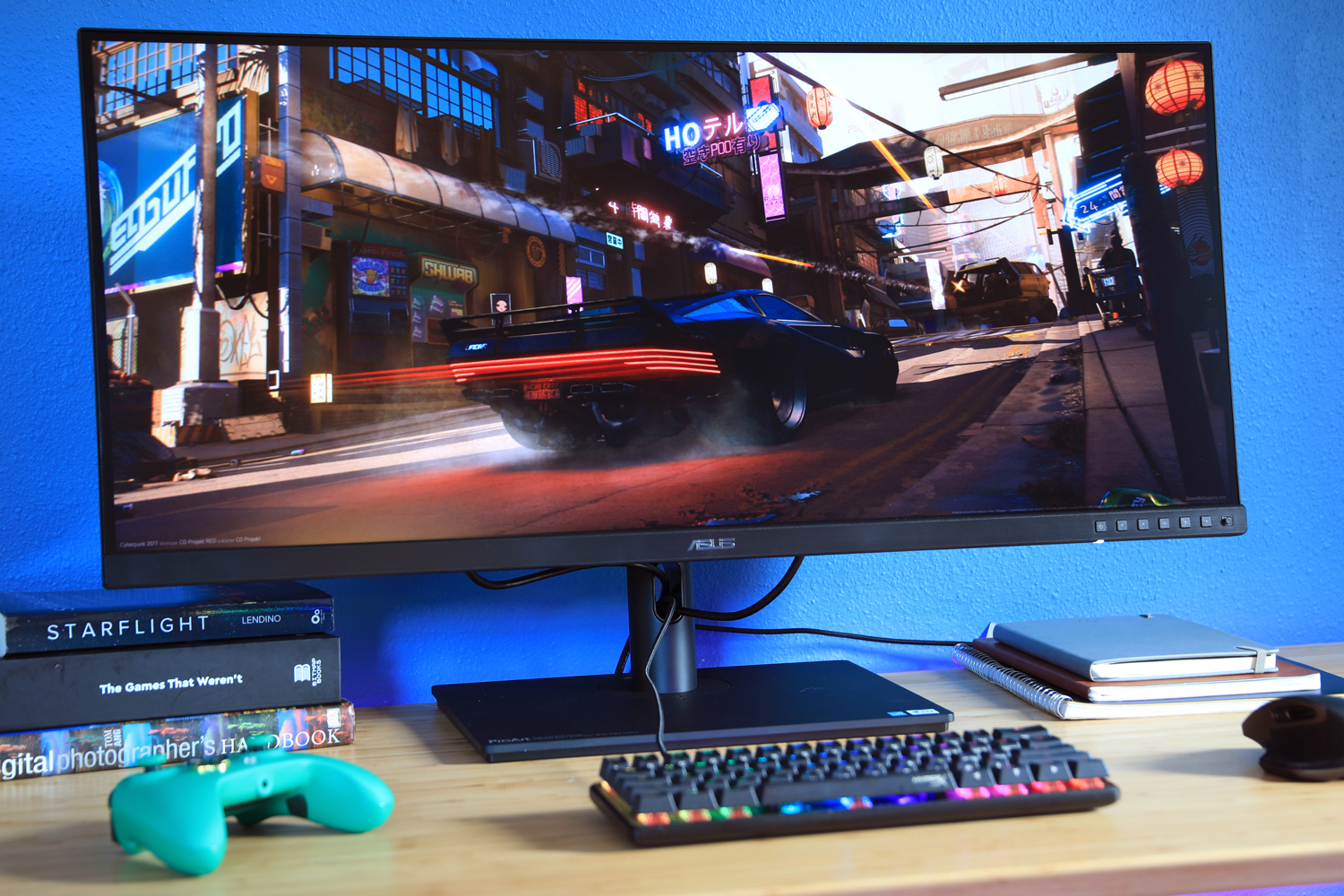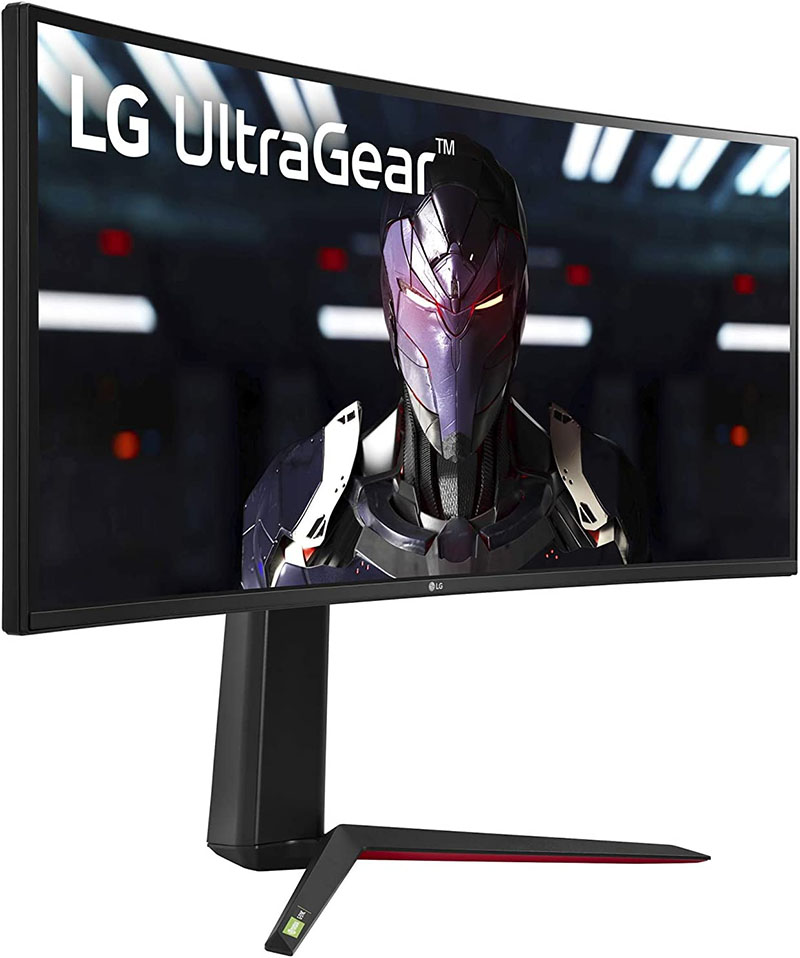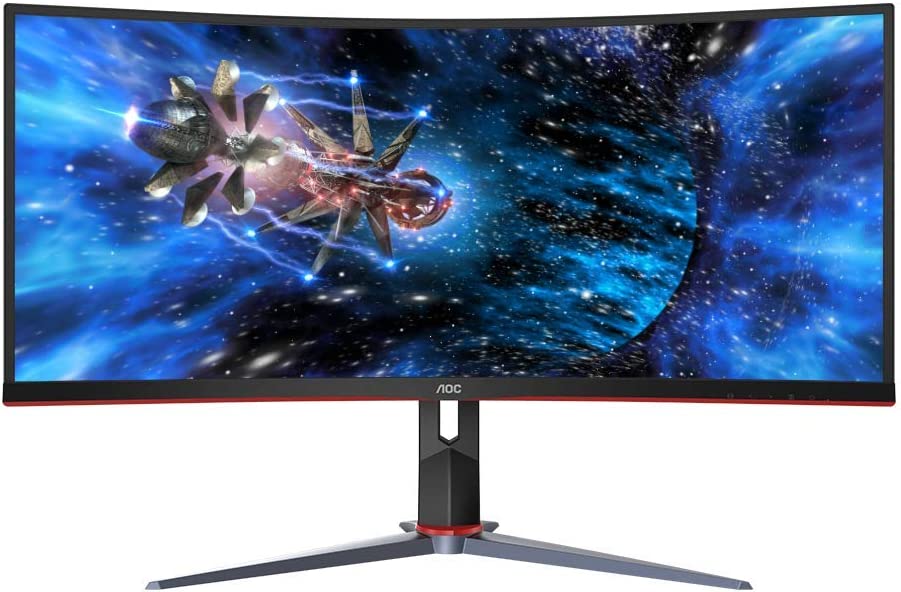Do you want a huge amount of usable display space, but also want to stick with a single monitor? If so, an ultrawide monitor is the ticket. These monitors have a wider display panel that’s far more impressive, and immersive, than your average widescreen. We’ve tested a bunch of ultrawide monitors in order to name the best picks in various categories. You can learn more about our evaluation process and what to look for in an ultrawide monitor below our recommendations.
You can find even more monitor recommendations in our roundup of the best monitors.
1. Alienware AW3423DWF – Best ultrawide monitor

Pros
- Excellent contrast ratio
- Top-notch color gamut and accuracy
- Great motion clarity
- Respectable HDR performance
- Extremely competitive price
Cons
- Stand is a bit too large
- No USB-C
- Maximum HDR brightness is lackluster
The Alienware AW3423DWF is a legendary monitor. It packs the incredible contrast and realism of OLED in a 34-inch widescreen panel, yet it’s priced at just $1,099. That’s not inexpensive, but it’s better value than other OLED monitors available right now.
Image quality is where it stands out. It delivers a vivid, immersive, rich experience with deep black levels and bright highlights, which are enhanced by the display’s glossy finish. Movies and games seem nearly three-dimensional—as if you’re looking through a window, not staring at a monitor.
What’s the catch? The monitor is not bright, especially in SDR, so it’s a bad choice for a brightly lit room. We also noticed the OLED panel has trouble rendering small fonts smoothly. These are minor issues, though, and shouldn’t trouble most owners.
This monitor targets gamers, so it offers an enhanced refresh rate of up to 165Hz and supports AMD FreeSync Premium Pro for smooth frame pacing in games. However, its excellent image quality will be impressive in everyday use, as well.
It has good connectivity, with two DisplayPort inputs and one HDMI, as well as a USB-A hub with four ports. There’s even a healthy range of calibration options that help demanding owners dial in the image to their personal specifications.
Read our full
Review Alienware AW3423DWF
2. Asus ProArt PA348CGV – Best ultrawide monitor for professionals

Pros
- Excellent SDR image quality
- Sturdy, hefty design
- Wide range of customization
- 120Hz refresh rate
Cons
- USB-C hub lacks video-out or ethernet
- HDR is merely passable
The Asus ProArt PA348CV surpassed our expectations. Priced at just $729.99, it’s towards the low end of pricing for a professional ultrawide display—yet its performance is near the top of the pack.
This monitor has a wide color gamut, excellent color accuracy, and a virtual buffet of image-quality calibration features that let users precisely tune the image. It’s also a bright and vivid monitor, making it easy to use in nearly any office. Admittedly, it doesn’t set any records in image quality tests—but it ties or comes close to alternatives that are hundreds of dollars more expensive.
Asus throws in a useful USB-C port that supports DisplayPort Alternate Mode and delivers 90 watts of USB Power Delivery. It also drives a USB-A hub with four downstream ports. Additional video connectivity includes two HDMI and one DisplayPort for a total of four input options.
Surprisingly, Asus throws in an enhanced refresh rate up to 120Hz. It’s not sold as a gaming monitor, but it can handle gaming well enough. That’s good news if you need one home office monitor for both work and play.
Read our full
Review Asus ProArt PA348CGV
3. LG Ultragear 34GN850 – Best budget ultrawide for gamers

Pros
- 21:9 panel with a 34-inch screen
- Curved monitor
- Impressive gaming performance
- Ergonomic adjustment options
Cons
- Only average power consumption
- Expensive
The LG Ultragear 34GN850-B, released in 2020, was once the king of ultrawide gaming. It was dethroned by Alienware’s AW3423DWF—and as a result LG has slashed the price. Originally $999.99, this monitor is now available for $699.99 (and sometimes less).
That’s great news. Although surpassed by the Alienware, LG’s Ultragear 34GN850-B is an attractive monitor with excellent color performance, good image clarity, and a bright, vivid picture. It has an enhanced refresh rate of up to 144Hz (with a 160Hz overclocked mode) and supports both AMD FreeSync and Nvidia G-Sync for smooth gameplay.
Its weakness? Contrast. The IPS panel scores lower in contrast than other monitors on this list, including the Asus ProArt PA348CV, which also has an IPS panel. The image can look hazy in darker scenes.
Connectivity is respectable with two HDMI ports, one DisplayPort, and two-port USB-A hub for connecting wired peripherals. The monitor also retains many of the features that would be expected of a high-end monitor including a sturdy ergonomic stand and attractive design.
Read our full
Review LG Ultragear 34GN850
4. AOC CU34G2X – Best budget ultrawide

Pros
- Gaming monitor in ultrawide 21:9 format
- Impressive gaming performance
- Large 34-inch curved panel
- Ergonomic adjustment options
Ultrawide monitors have many perks, but low pricing is not among them. Fortunately, budget shoppers have one good option: the AOC CU34G2X, which retails at or below $349.99.
This monitor has a 34-inch ultrawide VA panel that, by most measures, performs surprisingly close to more expensive alternatives. It provides a good contrast ratio and delivers vivid color performance. It also has the same 3440×1440 resolution as the other monitors on this list, so it looks just as sharp. In truth, less demanding shoppers may find it difficult to notice any difference between this monitor and more expensive options like the Asus ProArt PA348CV.
The AOC CU34G2X is marketed as a gaming monitor and has an enhanced refresh rate of up to 144Hz. It doesn’t officially support AMD FreeSync or Nvidia G-Sync, however, so gamers may have mixed results when trying to use these adaptive sync standards.
Though it punches above its price in image quality, the AOC CU34G2X’s design looks cheap. It leans a bit too hard on an aggressive red-and-black gaming theme. That will annoy shoppers who prefer a calmer, less obtrusive look.
Connectivity is great, though, with two HDMI and two DisplayPort inputs plus a four-port USB-A hub. The monitor also has a height adjustable stand, a must-have perk that isn’t guaranteed on budget ultrawide monitors.
Read our full
Review AOC CU34G2X
What to look for in an ultrawide monitor
Ultrawide monitors are a favorite of PC enthusiasts, but remain a niche within the larger monitor market. This leaves shoppers with fewer options. Most ultrawide monitors have a 34-inch panel with a resolution of 3440×1440, and similar connectivity.
Still, these monitors can differ in several key areas. Here’s what to look for.
Panel type is a big deal
Ultrawide monitors offer less choice in some regards but that script is flipped when it comes to panel type. Ultrawide monitors come in a variety of panel types: IPS, VA, and OLED.
IPS panels are common in mid-range and premium ultrawide monitors. This panel type delivers great color performance, high maximum brightness, superb sharpness, and good motion performance. It’s weak in contrast, however, which can disappoint when viewing TV shows or movies.
VA panels are typically a budget option, though some are found in premium ultrawide monitors. They have better contrast than IPS panels and deliver similar color performance and brightness—however, budget VA panels tend to be merely okay in these areas. Most VA panels fall short in motion performance and may look blurry when playing fast-paced games.
OLED is king of the hill. It leads in color, contrast, and motion performance. Sharpness is often slightly reduced compared to IPS and VA, but most people will find it a minor downgrade. OLED also is the best choice for HDR.
In general, OLED is better than IPS, and IPS is better than VA. However, some people might prefer VA over IPS because it has a better contrast ratio and looks darker in dark content.
A height-adjustable stand is a must-have
All the monitors on this list provide an ergonomic stand that adjusts for height, tilt, and swivel. This is a must-have feature, but one that isn’t found on the least expensive ultrawide monitors.
As tempting as it may be to save money on a budget model without a height-adjustable stand, you would regret it.
Ultrawide monitors are bulky and tend to require a larger, heavier stand, which in turn makes them more difficult to place on an elevated platform. The old college trick of sticking a monitor on a shoe box won’t work.
Look for USB-C, but don’t expect it
USB-C compatibility is an excellent feature, and USB-C hub monitors can clear away tons of clutter on your desk. Unfortunately, many ultrawide monitors don’t support USB-C yet, or have limitations that detract from the USB-C port’s usefulness.
Asus’s ProArt PA348CV, our favorite ultrawide for professionals, is one exception. It has a USB-C port with up to 90 watts of Power Delivery, and the port drives a USB-A hub with four downstream ports.
Dell, HP, and BenQ also offer ultrawide monitors with USB-C. Most of these lack an enhanced refresh rate, however, and they’re typically more expensive than the Asus.
Pricing is important—and can swing wildly
Monitor pricing is always important, but it’s key for ultrawide monitors. Although very expensive at MSRP, ultrawide monitors routinely see huge price cuts during seasonal sales. They also receive major semi-permanent price cuts later in their life.
The LG Ultragear 34GN850-B is an example of this. Originally sold for $999.99, it’s now routinely available for $699.99, and went as low as $599.99 during Amazon’s Black Friday sale. That’s a 40 percent reduction in price! Waiting for a deal can save you hundreds.
Don’t buy an ultrawide for console gaming
A quick word of warning: You should not buy an ultrawide monitor if you plan to connect a game console frequently.
Game consoles don’t support ultrawide aspect ratios, so you’ll see black bars on either side of the image. That’s unattractive and wastes the monitor’s potential. It’s best to stick with a widescreen monitor if console gaming is a priority.
How we test monitors
PC World’s team of staff and freelance reviewers conduct in-depth testing to compare monitors across a wide range of categories and price points. We test dozens of monitors each year to find the best pick for every category and price point.
Our testing uses a SpyderXElite color calibration tool. It delivers objective, unbiased measurements for a wide range of metrics including brightness, contrast, color gamut, color accuracy, color temperature, and gamma. Results are recorded and logged for future comparison. This allows our experts to easily compare many monitors at once and eliminates subjective bias from the results.
Stay connected with us on social media platform for instant update click here to join our Twitter, & Facebook
We are now on Telegram. Click here to join our channel (@TechiUpdate) and stay updated with the latest Technology headlines.
For all the latest Technology News Click Here
For the latest news and updates, follow us on Google News.
